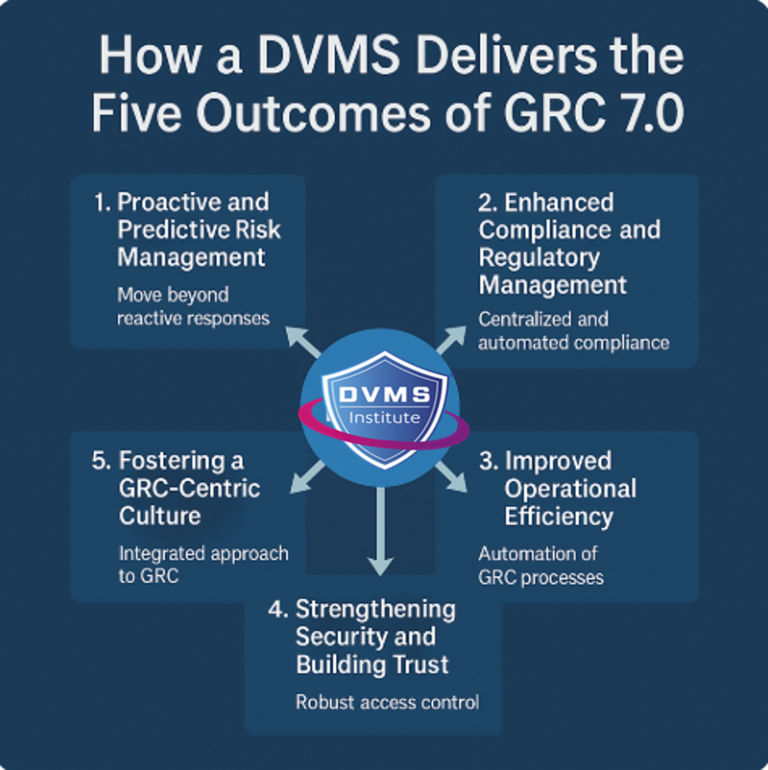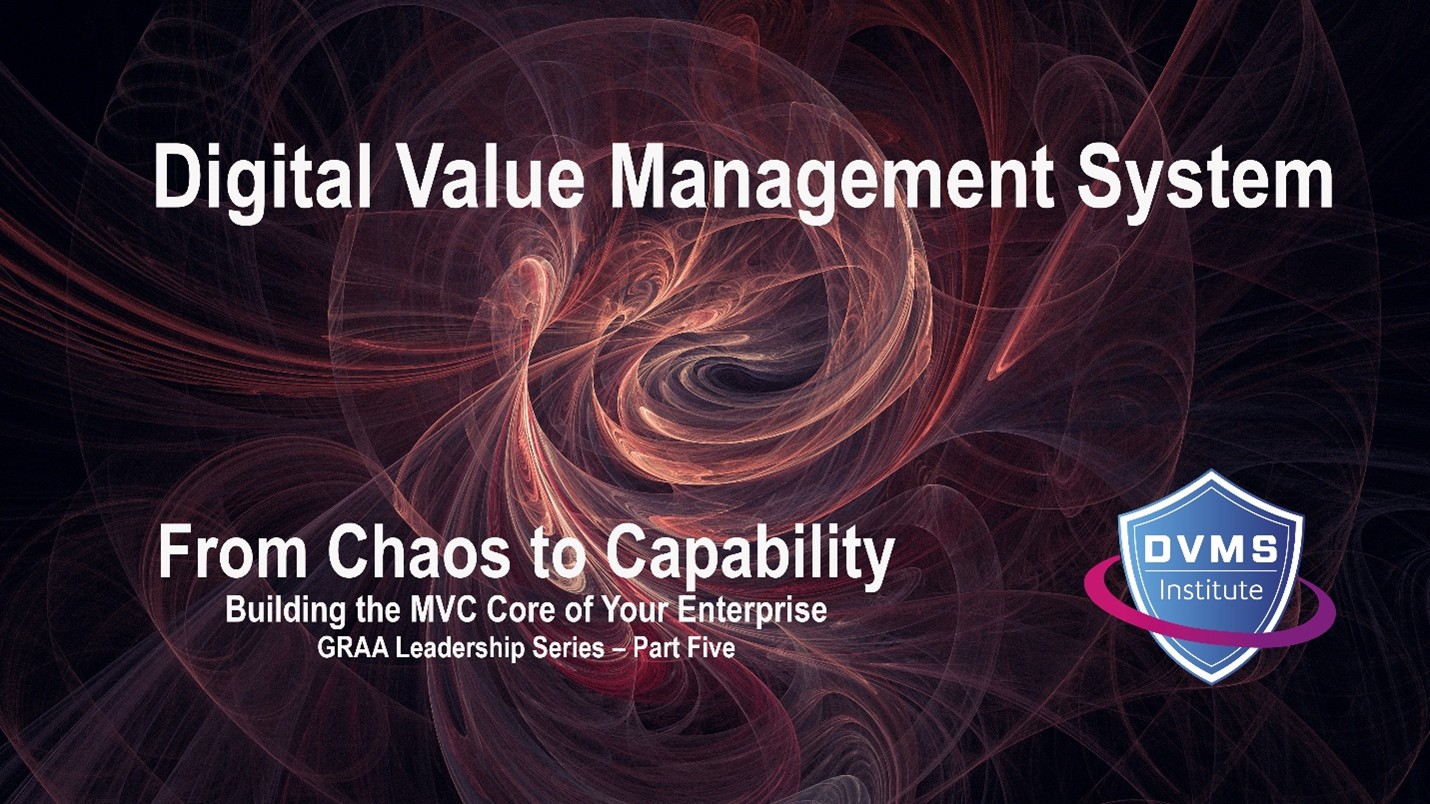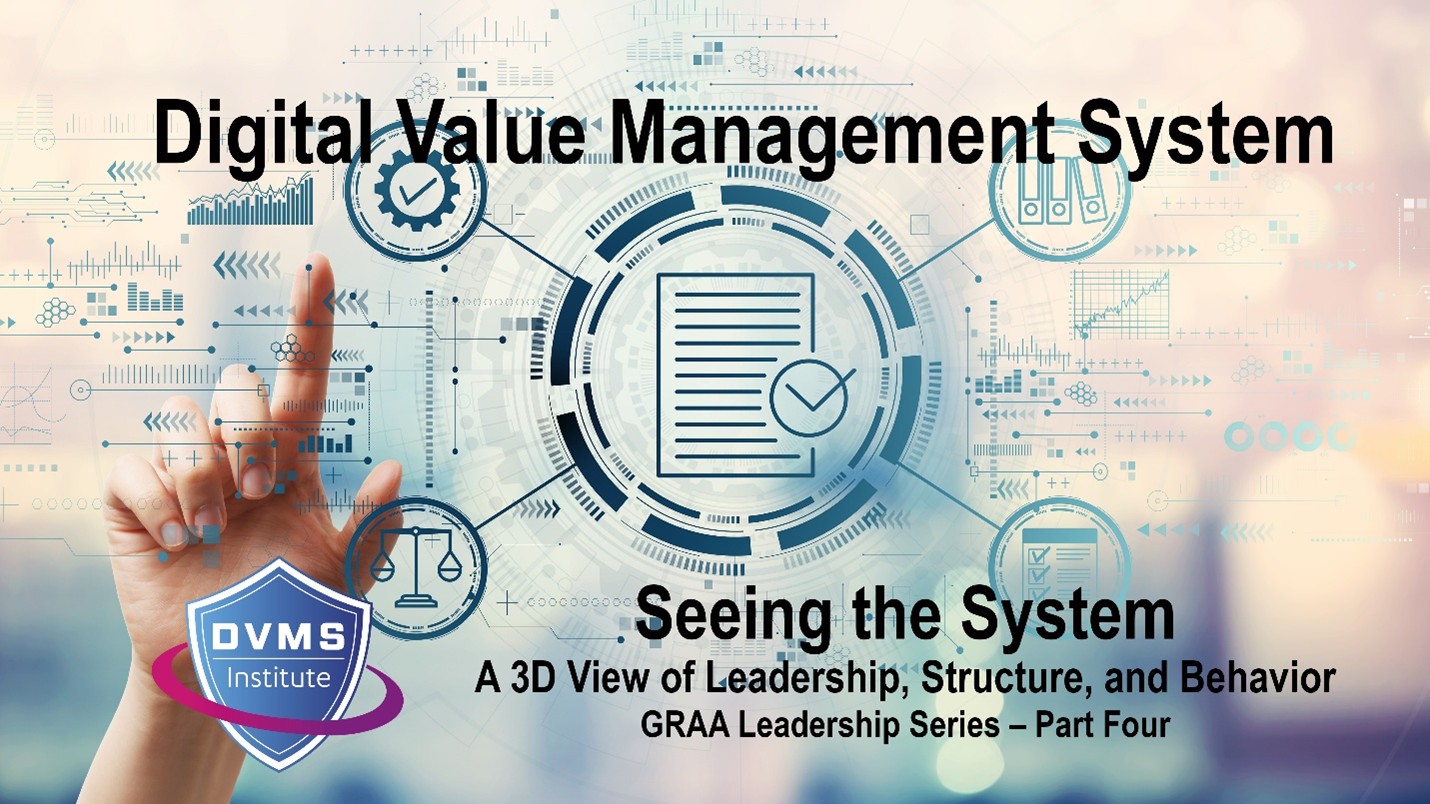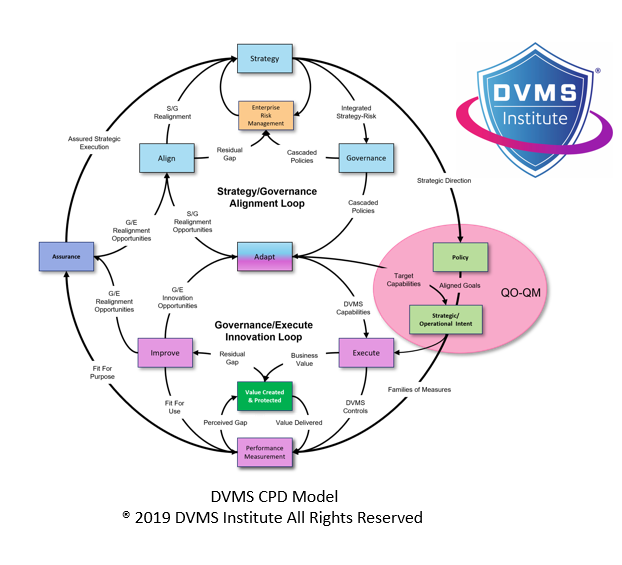How the Digital Value Management System (DVMS) Delivers the Outcomes of GRC 7.0
Rick Lemieux – Co-Founder and Chief Product Officer of the DVMS Institute
Introduction: Bridging Strategy, Risk, and Resilience
Governance, Risk, and Compliance (GRC) 7.0 defines a future-ready paradigm that enables organizations to make principled performance decisions while addressing complexity, uncertainty, and change. The Digital Value Management System (DVMS), through its overlay model and integration with the NIST Cybersecurity Framework (CSF) 2.0, delivers these outcomes by embedding cybersecurity and digital risk management into the very fabric of how value is created, protected, and delivered. DVMS aligns with GRC 7.0 by promoting an adaptive, systems-based approach to enterprise governance, strategic alignment, risk-informed decision-making, and cultural transformation.
1. Governance: Embedding Cybersecurity in Strategic Oversight
DVMS begins with the understanding that governance is not a function but a core capability. It reframes cybersecurity from a technical afterthought to an integral component of enterprise governance. Organizations operationalize the strategic oversight of digital risks by embedding cybersecurity governance within the DVMS’s “Govern” capability and the CPD (Create, Protect, Deliver) Model. These risks are no longer viewed as standalone threats but as variables in strategic execution, supporting GRC 7.0’s principle of aligning performance with purpose.
The DVMS’s MVC ZX Model defines “Govern” as establishing the policies and oversight that guide the creation and protection of digital value, ensuring alignment with mission objectives. This aligns with the NIST CSF 2.0 GOVERN function, which promotes enterprise-wide risk-informed strategy formation, stakeholder accountability, and policy enforcement.
2. Risk Management: Strategy-Risk as a Unified Concept
Where GRC 7.0 emphasizes risk as a value enabler, DVMS advances the novel construct of “strategy-risk,” treating risk and strategy as a single inseparable entity. This is a foundational departure from traditional reactive risk management approaches. In the DVMS, all strategic objectives must be informed by digital business risk, and that risk must be contextualized in how value is created and delivered.
The Practitioner’s Guide articulates how DVMS overlays enterprise operations with a system for identifying, analyzing, and closing performance gaps. DVMS tools like QO-QM (Question-Outcome–Question-Metric) provide a method for developing strategic alignment between objectives, operational metrics, and controls, enabling organizations to proactively manage uncertainty, as encouraged by GRC 7.0.
3. Compliance and Assurance: Cultural Alignment and Resilience
DVMS moves compliance away from checklist-driven behavior toward a cultural practice of principled performance. This is achieved through the DVMS’s “Assure” capability, which provides mechanisms to validate whether activities across the organization are aligned with governance policies, risk tolerances, and stakeholder expectations.
GRC 7.0 recognizes that culture is central to resilience and compliance. DVMS addresses this through its cultural web model and continual learning paradigm. It facilitates cultural alignment by ensuring that leadership, communication, rituals, and structures all reflect the strategic and ethical commitments of the organization. The DVMS encourages organizations to transition from reactive control to adaptive assurance by integrating cultural diagnostics, collaborative governance, and values-based behaviors into day-to-day operations.
4. Integration: System of Systems Thinking and Overlay Architecture
DVMS supports the GRC 7.0 principle of integration by presenting itself as an overlay—rather than a replacement—for existing enterprise best practice frameworks (ITIL, NIST-CSF, COBIT etc.) processes, and organizational capabilities. It aligns with NIST CSF 2.0’s Profiles and Tiers by enabling organizations to map current and target cybersecurity outcomes across governance and execution layers.
By treating the organization as a system of systems, DVMS ensures that cybersecurity is not siloed within IT but integrated across all business units. This overlay approach allows the DVMS to expose and remediate gaps in digital value protection, streamline compliance obligations, and harmonize cybersecurity operations with business strategy.
5. Agility and Innovation: Thriving on the Edge of Chaos
GRC 7.0 encourages organizations to become more agile and responsive. DVMS enables this through the “Innovate” and “Change” capabilities in the MVC Z-X Model, encouraging continual adaptation of both policies and operational processes. The “Innovate” capability includes incremental, sustaining, adaptive, and disruptive innovation, aligning with GRC 7.0’s emphasis on continuous improvement and dynamic capabilities.
Moreover, DVMS’s learning organization philosophy—rooted in systems thinking and feedback loops—supports what GRC 7.0 calls “dynamic governance.” It empowers organizations to make decisions under uncertainty, learn from incidents, and evolve in response to complex environments.
6. Outcomes-Based Performance: Measuring What Matters
DVMS helps organizations deliver measurable outcomes using structured models like GQM (Goal-Question-Metric) and QO-QM. These models ensure that cybersecurity and resilience efforts are tied directly to business outcomes and stakeholder expectations. GRC 7.0 stresses performance assurance through meaningful measurement; DVMS operationalizes this by providing both qualitative and quantitative evaluation mechanisms that bridge strategy and operations.
Through DVMS’s CPD Model and alignment with NIST CSF Subcategories, organizations can create dashboards that reflect their progress in achieving strategic goals, protecting critical assets, and sustaining operational continuity in the face of cyber threats.
Conclusion: The DVMS as a Realization Engine for GRC 7.0
DVMS embodies the principles of GRC 7.0 by treating cybersecurity as an enterprise-wide responsibility, embedding it into governance structures, risk strategies, assurance mechanisms, and cultural values. It transcends the limitations of traditional compliance programs by creating an adaptable, scalable, and resilient system of management aligned with the dynamic needs of digital business.
By shifting from a control-centric mindset to a systems-based, outcome-oriented paradigm, DVMS ensures that organizations comply with regulations and thrive in uncertainty—delivering on the GRC 7.0 promise of principled performance and digital trust.
About the Author

Rick Lemieux
Co-Founder and Chief Product Officer of the DVMS Institute
Rick has 40+ years of passion and experience creating solutions to give organizations a competitive edge in their service markets. In 2015, Rick was identified as one of the top five IT Entrepreneurs in the State of Rhode Island by the TECH 10 awards for developing innovative training and mentoring solutions for boards, senior executives, and operational stakeholders.
In today’s digitally driven economy, cyber disruptions are no longer an “if” but a “when.”
The DVMS Institute’s Certified Training Programs teach organizations the skills to build a Holistic and Culture-Aligned Overlay System capable of coordinating Adaptive, Governance, Resilience, and Assurance actions across a Complex Digital Ecosystem.
Achieving true cyber resilience across a complex digital ecosystem requires seamless alignment between organizational Strategy, Governance, and Operations, underpinned by a culture dedicated to sustaining and continuously innovating organizational digital value.
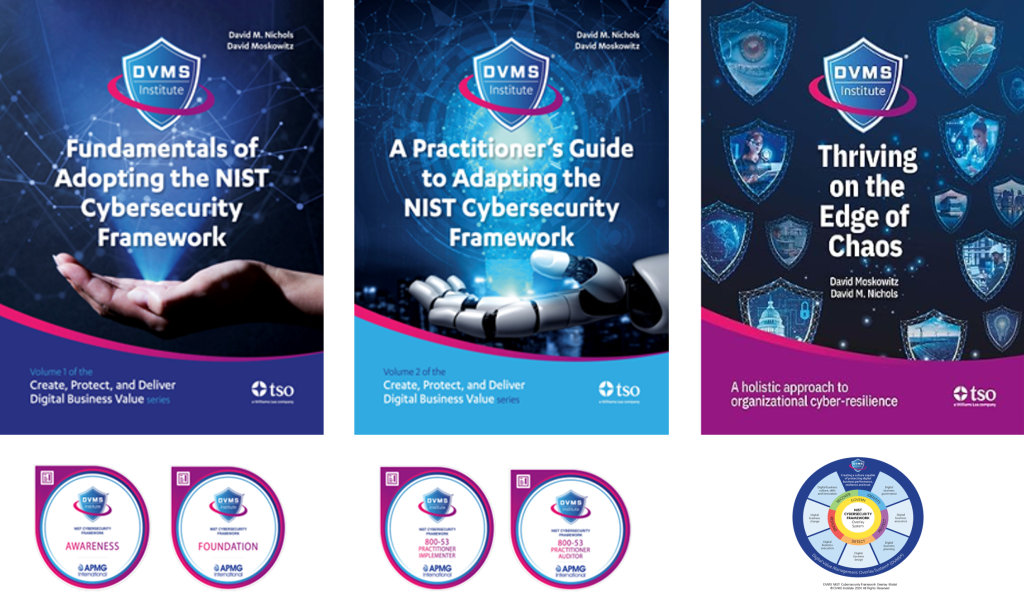
The DVMS positions cyber resilience as a strategic, enterprise-wide capability powered by the Institute’s CPD, Z-X, and 3D Knowledge models.
This systems-based approach to cyber operational resilience demands active engagement from all members of the Digital Ecosystem, with each member playing a distinct role in proactively identifying and mitigating the systemic risks that threaten digital business operations.
This adaptive, forward-looking approach to Governance, Resilience, and Assurance (GRA) positions businesses to:
- Maintain Operational Stability Amidst Constant Digital Disruption
- Drive Agility and Trust Across Your Digital Ecosystem
- Satisfy Critical Regulatory and Certification Requirements
- Leverage Cyber Resilience as a Competitive Advantage
DVMS Explainer Videos
- Architecture Video: David Moskowitz explains the DVMS System
- Case Study Video: Dr. Joseph Baugh Shares His DVMS Story.
- Overlay Model – What is an Overlay Model
- ZX Model – The MVC’s that power operational resilience
- CPD Model – Adaptable governance and assurance
- 3D Knowledge Model – Enabling holistic organizational learning
- FastTrack Model – A phased approach to cyber resilience
Digital Value Management System® is a registered trademark of the DVMS Institute LLC.
® DVMS Institute 2025 All Rights Reserved

